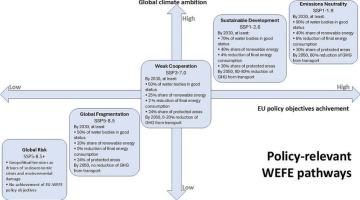制定与政策相关的水-能源-食物-生态系统联系途径的叙述:全球和欧盟驱动因素如何相互作用
IF 11.2
1区 社会学
Q1 ENVIRONMENTAL STUDIES
引用次数: 0
摘要
共享社会经济路径(ssp)和代表性浓度路径(rcp)是为社会经济和气候变化评估而创建的,在全球环境评估中得到了广泛的应用。然而,水资源、能源、粮食和生态系统(WEFE)的SSP-RCP路径和政策的绘制仍然难以捉摸。如何将当前欧盟(EU)政策与气候和社会经济途径相结合存在不确定性。为了解决这种不确定性,我们与广泛的利益相关者和专家合作,制定了描述2050年之前可能与政策相关的WEFE联系途径的叙述。通过对欧盟-WEFE政策的路径映射,确定了与政策相关的三个主要路径,即“可持续发展”、“弱合作”和“全球碎片化”,以及两个极端路径,即“排放中和”和“全球风险”。对于每一种途径,都发展了一种叙述,解释了全球和欧盟驱动因素如何相互作用。这些叙述综合了气候、社会经济和治理驱动因素。研究结果表明,排放中和途径需要全球和欧盟承诺之间的高度协调。另一方面,全球碎片化代表了欧盟充满挑战的未来,表明全球趋势将制约欧盟-世界经济论坛目标的实现,并突出了全球协调的必要性。除了结果之外,这些叙述有助于更好地理解WEFE的联系。此外,它们可以作为探索潜在未来发展和评估WEFE联系解决方案的基础。本文章由计算机程序翻译,如有差异,请以英文原文为准。

Developing narratives for policy-relevant water-energy-food-ecosystem nexus pathways: How global and European Union drivers interact
The shared socioeconomic pathways (SSPs) and representative concentration pathways (RCPs) were created for socioeconomic and climate change assessments and are widely used in global environmental assessments. However, mapping SSP-RCP pathways and policies for water, energy, food and ecosystems (WEFE) remains elusive. There is uncertainty on how to integrate current European Union (EU) policies with climate and socioeconomic pathways. To address that uncertainty, we developed narratives describing possible policy-relevant WEFE nexus pathways until 2050 by collaborating with a broad range of stakeholders and experts. By mapping several SSP-RCP pathways with EU-WEFE policies, three primary policy-relevant WEFE pathways, namely “Sustainable Development,” “Weak Cooperation,” and “Global Fragmentation”, and two extreme pathways, “Emissions Neutrality” and “Global Risk,” were identified. For each of these pathways, a narrative was developed explaining how global and EU drivers interact. These narratives integrate climate, socioeconomic and governance drivers. Findings show that the Emissions Neutrality pathway would require a high level of coordination between global and EU commitments. At the other end, Global Fragmentation represents a challenging future for the EU, showing that the global trends will condition the achievement of EU-WEFE objectives and highlighting the need for global coordination. Beyond the results, these narratives contribute to a better understanding of WEFE nexus. Furthermore, they can serve as a basis to explore potential future developments and asses WEFE nexus solutions.
求助全文
通过发布文献求助,成功后即可免费获取论文全文。
去求助
来源期刊

Environmental Impact Assessment Review
ENVIRONMENTAL STUDIES-
CiteScore
12.60
自引率
10.10%
发文量
200
审稿时长
33 days
期刊介绍:
Environmental Impact Assessment Review is an interdisciplinary journal that serves a global audience of practitioners, policymakers, and academics involved in assessing the environmental impact of policies, projects, processes, and products. The journal focuses on innovative theory and practice in environmental impact assessment (EIA). Papers are expected to present innovative ideas, be topical, and coherent. The journal emphasizes concepts, methods, techniques, approaches, and systems related to EIA theory and practice.
 求助内容:
求助内容: 应助结果提醒方式:
应助结果提醒方式:


